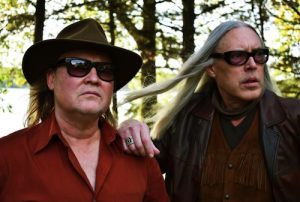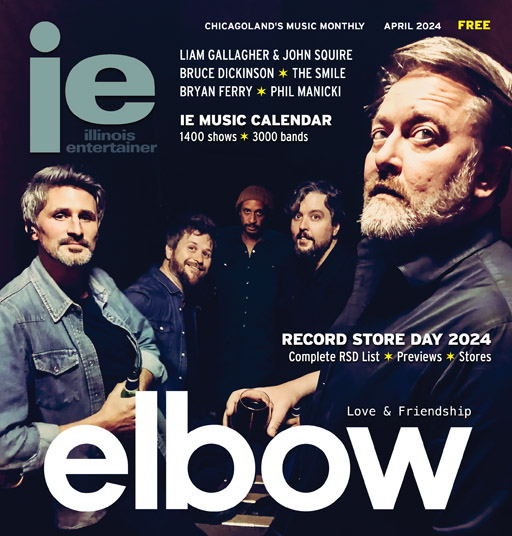Cover Story: Urge Overkill • “Oui, Oui”
Time flies – especially if you mark time by 11s and years and releases from your favorite rock band – at least if that band is Urge Overkill. Some may feel it’s been a long time since their last release, Rock & Roll Submarine; others may say it feels like yesterday. It may undoubtedly sound like yesterday when you listen to their new album Oui, out now on Omnivore Recordings. Some people might feel that “time” as a forward-moving construct is suspect, especially after living with the inertia caused by a pandemic that is three years in the making. And while some believe time and progress are interwoven, if you’re Nash Kato and Eddie “King” Roeser, progress can present itself as the proverbial double-edged sword.
“When any recording from the past is available digitally within seconds, you have less of a sense that what’s happening in the present is really important,” said Roeser. “It used to be more of an idea that things were moving forward. Now everybody has access to everything that has ever happened. And I think there’s less of an urgency or sense that passing of time is that important.”
While the band began its career churning out records almost annually, the change of schedule to once a decade might be frustrating, for fans at least. But what about the band? Why not three, five, or seven years in between records instead of 10?
‘It did not take ten years to create Oui by any stretch,” said Kato. “Back in the day, you had a weekend or a week in the studio to crank out an album, and these days it’s ProTools – everything’s digital. It was something we started chipping away at.”
“I think we were pretty relaxed about the releasing of this record, and we weren’t on any sort of schedule because what does it matter?” Roeser mused. “I didn’t realize how many records were coming out, but while we’re promoting this record, it’s like, ‘you got in the Top 10 of this website – but there were 45 songs introduced on this website just today.’ So it’s a mindboggling amount [of music]. I think there’s a definite clogging of the airwaves. Not only that, but it changes the way one thinks about the present. When I see my son, there’s so much other interesting stuff he can be involved in – he’s got games, he can hang out with his friends without being physically present… There’s so much else to fill your head. I sort of feel – and I know Nash agrees, we did live in a Golden Age for music, occupying a more central place in the cultural brain, if you will.”
Urge Overkill (essentially now the duo of Kato and Roeser) has been a torchbearer of indie rock – by definition independent of any carved-out genre “occupying the cultural brain” for over 35 years. Their nascent days as an eager college band signed to Chicago-based label Touch & Go found them making a lot of deliberate noise at requisite volume with the help of Steve Albini on 1989’s Jesus Urge Superstar, and a year later on the Butch Vig-produced Americruiser. Their major-label debut Saturation, produced by the Butcher Bros. (Cypress Hill, Nine Inch Nails, Anthrax) remains to this day a fan and critic favorite, standing the test of time (time stands still when the moment is right), along with their Neil Diamond cover “Girl, You’ll Be a Woman Soon” which was memorialized on the soundtrack to Quentin Tarantino’s 1994 film Pulp Fiction, both worldwide hits which brought Urge Overkill along for the ride.
Although they met while attending Northwestern University, and throughout the ‘90s, they could be found at shows of their Chicago peers or holding court in the wee hours at the (sadly razed) Marie’s Riptide Lounge, the truth is most of their albums were conceived in Minnesota.
“We couldn’t afford a rehearsal space in the city, and but the King grew up in rural Minnesota,” Kato explained. “Most of [our] albums were conceived in a barn in rural Minnesota. So it was funny that we were always known as a Chicago-based band; we did our time in Minnesota because it was all we could afford!”
Unfortunately, their follow-up LP Exit The Dragon didn’t continue the momentum as all involved had hoped it would. Then some bad juju began to drag the band down – drugs, arrests, fights amongst band members (as well as with other bands) were ultimately the death of that iteration of Urge Overkill. By the end of 1996, tensions between Kato and Roeser were too much, so Roeser left the band. Kato and drummer Blackie Onassis continued as a duo and jumped ship from DGC to 550 Music in 1997. But even with new guitarist Nils St. Cyr and a new label home, they couldn’t rekindle the fire, so UO officially disbanded.
Kato released a solo debut in early 2000; then, the band (minus Onassis) reunited for a worldwide tour in 2004. But it wasn’t until 2010 that Kato and Roeser decided to return to the recording studio to write again. (Could having the honor of being invited to play at Quentin Tarantino’s Friar’s Club roast in December of that year have anything to do with their renewed inspiration? Rubbing elbows with the likes of Samuel L. Jackson, John Travolta, Uma Thurman, Patricia Arquette, Sarah Silverman, and over 2,200 other Hollywood successes? Who knows. “It was surreal,” said Kato.) In May 2011, “UO 3.0,” which included Kato and Roeser, ex-Polvo drummer Bonn Quast and ex-Gaza Strippers bassist Mike “Hadji” Hodgkiss, released its first record in 16 years, Rock & Roll Submarine.
While that record was called a “rousing comeback” for sticking to their old school, scabrous approach to recording, it should be no surprise, then, that the new album Oui continues where R&RS left off since many of the new songs came from those recording sessions.
“To be honest, we’d completely forgotten where all of the original recording was done, but it does say on the record where some of it was,” Roeser admitted. “But the record does have a spiritual home at this studio over one winter. My high school buddy had located these sons of Bobby Vee; they have a great facility in St. Joseph, Minnesota called Rockhouse Studios. It’s an old bank building built on the specs of Abbey Road; this is what they told us. The main room – the drum room – has very similar acoustics to how Abbey Road was built. I think we were up there for a few different sessions that lasted maybe three weeks at a time. It’s all a little foggy now, but… That town has a great coffee shop and a bar, and that’s all we need. “They were right next door; it really came in handy,” Kato added.
“We were able to hang out for a winter up there and take our time and go through what we had, and what we didn’t have we recorded there,” Roeser continued. “For instance, ‘Freedom’ was recorded there as a band very quickly. And I think we had another version of ‘Necessary Evil’; that was something we thought we were going to fix from a demo, but that was a complete re-recording. I remember “Amanda Knox” was completely recorded there.
For Kato and Roeser, the adage “If it ain’t broke, don’t fix it” seems increasingly apropos… Or, in this case, maybe just fix it a little.
“You’ll have a song that will be pretty much intact from the studio we recorded it in, and maybe have an improved vocal scheme, for instance,” Roeser explained. “It’s pretty common, even in the pre-digital days, to record the basic tracks somewhere, and you would go to a vocal specialist to finish out the vocals, or maybe put some horn tracks on something somewhere else.”
Roeser continued: “It took some alteration, and choosing not to use some songs that we really like, and fixing some songs that weren’t as good as what you can do digitally now. If you have something that’s at 90 percent and you’ve heard it one way a million times, but then you take a step back, like a couple years back, you can step [back] into a song and make it a whole lot better. Or maybe another guy in the band hears something different in it.”
Sonically, Oui isn’t a far stretch from the last LP, as it continues to showcase a not-too-fine honing of their signature amalgam of ‘70s prog rock, ‘80s arena rock, and ‘90s grunge. The record starts with a surprisingly cheerful and deliberately imperfect cover of Wham!’s “Freedom” opens the record. They had heard the song while riding in a cab in Moscow during an acoustic overseas tour in ‘04.
“It occupies a place of honor on the record because it functioned as a sort of ice-breaker when we went to the Rock House Studio in St. Joseph, Minnesota,” Roeser explained. “You’re always wondering which song to break the ice with, and there’s always nerves, and it’s a little forced… It was a way to play something that maybe wasn’t going to be crucial to the record. And we had a lot of fun doing it because it was low pressure… It wasn’t planned.”
The rest of the record unfolds like scenes in a film fading in and out. “Necessary Evil” is a moody Roeser trope about the secrets lovers keep… “Follow My Shadow” is a KISS-esque anthem with meaty guitars and layered vocals… “How Sweet The Light” is Kato’s ode, some say, to his late friend Jim Ellison, or at least to those who lost the inner battle, and how grateful he is not to have taken the same road: “Jesus, Mary, Jehovah, I almost crossed over” – buoyed by dichotomously chimney, Cheap Trick-y guitars and big drum fills… “A Prisoner’s Dilemma” is an ambitious, multilayered, cheeky ode to Amanda Knox, the young American woman who was accused and convicted of murdering her roommate and fellow exchange student in Italy in 2007… “Forgiven” is a driving blues-rock number… “Litany” is a hard-rock track that builds up to a searing crescendo that would turn any Pantera fan on… “I Can’t Stay Glad@U” is a love song: “You’re high upon the mountain – while I in the valley of madness – When our love burns & crashes – you will still rise from the ashes”… The record closes on “Snow,” a Roeser tune that shares the same brooding elements as Dinosaur Jr., Sonic Youth, and Pixies.
“I think after the fact, I see more cohesion there, which often that happens with Urge,” said Roeser. “It’s not like we have some secret plan to put something there for people to uncover. But certain themes in hindsight come out and make sense; even the subject matter of ‘freedom’ could be about the band, or me, and Nash or whatever, and making a stand. We never discuss those things. Some of the expansive themes are, I guess, more mythological than specific.”
Kato adds: “We’re old school; we’re very fortunate that everything we’ve put out was pressed into vinyl. So obviously, when we go to make an album, we think A side-B side.”
“I don’t know how many other bands still think of constructing things in that way, but that’s how we do it – we still think of it as a platter that’s spinning,” Roeser added. “I heard the test pressing, and it sounded fantastic. And when I heard ‘Forgiven’ on XRT the other night, they had a digital copy and put it through their compressors or whatever. But I swear to god, this thing sounded ten times better on my vinyl copy than it did over the radio. Nash and I were both astounded at the improvement that came over the whole thing when we got our vinyl test pressings back. The record just seemed to really make sense when you hear it on vinyl.”
How serendipitous, then, that vinyl has been making a comeback. And so is UO.
-Penelope Biver
Category: Cover Story, Featured, Monthly










